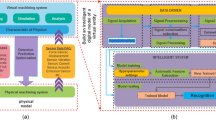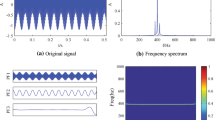Abstract
Machining state monitoring is an important subject for intelligent manufacturing. Feature construction is accepted to be the most critical procedure for a signal-based monitoring system and has attracted a lot of research interest. The traditional manual constructing way is skill intensive and the performance cannot be guaranteed. This paper presented an automatic feature construction method which can reveal the inherent relationship between the input vibration signals and the output machining states, including idling moving, stable cutting and chatter, using a reasonable and mathematical way. Firstly a large signal set is carefully prepared by a series of machining experiments followed by some necessary preprocessing. And then, a deep belief network is trained on the signal set to automatically construct features using the two step training procedure, namely unsupervised greedily layer-wise pertaining and supervised fine-tuning. The automatically extracted features can exactly reveal the connection between the vibration signal and the machining states. Using the automatic extracted features, even a linear classifier can easily achieve nearly 100% modeling accuracy and wonderful generalization performance, besides good repeatability precision on a large well prepared signal set. For the actual online application, voting strategy is introduced to smooth the predicted states and make the final state identification to ensure the detection reliability by taking consideration of the machining history. Experiments proved the proposed method to be efficient in protecting the workpiece from serious chatter damage.












Similar content being viewed by others
References
Abellan-Nebot, J. V., & Subirón, F. R. (2010). A review of machining monitoring systems based on artificial intelligence process models. International Journal of Advanced Manufacturing Technology, 47(1–4), 237–257.
Altintas, Y. (2012). Manufacturing automation: metal cutting mechanics, machine tool vibrations, and CNC design. Cambridge: Cambridge University Press.
Aydin, I., Karakose, M., & Akin, E. (2015). Combined intelligent methods based on wireless sensor networks for condition monitoring and fault diagnosis. Journal of Intelligent Manufacturing, 26(4), 717–729.
Bengio, Y. (2009). Learning deep architectures for AI. Foundations and Trends in Machine Learning, 2(1), 1–127.
Bengio, Y. (2013). Deep learning of representations: Looking forward. In A. H. Dediu, C. Martín-Vide, R. Mitkov, & B. Truthe (Eds.), Statistical language and speech processing. First international conference, SLSP 2013, Tarragona, Spain, July 29–31, 2013. Proceedings (pp. 1–37). Springer Berlin Heidelberg.
Bengio, Y., Courville, A., & Vincent, P. (2013). Representation learning: A review and new perspectives. IEEE Transactions on Pattern Analysis and Machine Intelligence, 35(8), 1798–1828.
Cho, S. Y., Binsaeid, S., & Asfour, S. (2010). Design of multisensor fusion-based tool condition monitoring system in end milling. International Journal of Advanced Manufacturing Technology, 46(5–8), 681–694.
Fu, Y., Zhang, Y., Zhou, H., Li, D., Liu, H., Qiao, H., et al. (2016). Timely online chatter detection in end milling process. Mechanical Systems and Signal Processing, 75, 668–688.
Goodfellow, I. J., Erhan, D., Carrier, P. L., Courville, A., Mirza, M., Hamner, B., et al. (2014). Challenges in representation learning: A report on three machine learning contests. Neural Networks.
Hinton, G. (2010). A practical guide to training restricted Boltzmann machines. Momentum, 9(1), 926.
Hinton, G., Deng, L., Yu, D., Dahl, G. E., Jaitly, N., Mohamed, A. R., et al. (2012). Deep neural networks for acoustic modeling in speech recognition: The shared views of four research groups. IEEE Signal Processing Magazine, 29(6), 82–97.
Hinton, G. E. (2002). Training products of experts by minimizing contrastive divergence. Neural Computation, 14(8), 1771–1800.
Hinton, G. E., & Salakhutdinov, R. R. (2006). Reducing the dimensionality of data with neural networks. Science, 313(5786), 504–507.
Hubel, D. H., & Wiesel, T. N. (1962). Receptive fields, binocular interaction and functional architecture in the cat’s visual cortex. The Journal of physiology, 160(1), 106.
Jolliffe, I. (2002). Principal component analysis. Wiley Online Library.
Kuljanic, E., Sortino, M., & Totis, G. (2008). Multisensor approaches for chatter detection in milling. Journal of Sound and Vibration, 312(4–5), 672–693.
Kuljanic, E., Totis, G., & Sortino, M. (2009). Development of an intelligent multisensor chatter detection system in milling. Mechanical Systems and Signal Processing, 23(5), 1704–1718.
Lamraoui, M., Thomas, M., El Badaoui, M., & Girardin, E. (2014). Indicators for monitoring chatter in milling based on instantaneous angular speeds. Mechanical Systems and Signal Processing, 44(1–2), 72–85.
LeCun, Y., Bengio, Y., & Hinton, G. (2015). Deep learning. Nature, 521(7553), 436–444.
Litak, G., Sen, A. K., & Syta, A. (2009). Intermittent and chaotic vibrations in a regenerative cutting process. Chaos Solitons & Fractals, 41(4), 2115–2122.
Liu, H. Q., Chen, Q. H., Li, B., Mao, X. Y., Mao, K. M., & Peng, F. Y. (2011). On-line chatter detection using servo motor current signal in turning. Science China Technological Sciences, 54(12), 3119–3129.
Mohamed, A. R., Dahl, G. E., & Hinton, G. (2012). Acoustic modeling using deep belief networks. IEEE Transactions on Audio, Speech, and Language Processing, 20(1), 14–22.
Quintana, G., Ciurana, J., Altintas, Y., & Weck, M. (2011). Chatter in machining processes: A review. International Journal of Machine Tools & Manufacture, 51(5), 363–376.
Schmitz, T. L. (2003). Chatter recognition by a statistical evaluation of the synchronously sampled audio signal. Journal of Sound and Vibration, 262(3), 721–730.
Sick, B. (2002). On-line and indirect tool wear monitoring in turning with artificial neural networks: A review of more than a decade of research. Mechanical Systems and Signal Processing, 16(4), 487–546.
Siddhpura, A., & Paurobally, R. (2013). A review of flank wear prediction methods for tool condition monitoring in a turning process. International Journal of Advanced Manufacturing Technology, 65(1–4), 371–393.
Siddhpura, M., & Paurobally, R. (2012). A review of chatter vibration research in turning. International Journal of Machine Tools & Manufacture, 61, 27–47.
Tangjitsitcharoen, S. (2011). Advance in detection system to improve the stability and capability of CNC turning process. Journal of Intelligent Manufacturing, 22(6), 843–852.
Tangjitsitcharoen, S., & Pongsathornwiwat, N. (2013). Development of chatter detection in milling processes. International Journal of Advanced Manufacturing Technology, 65(5–8), 919–927.
Tangjitsitcharoen, S., Saksri, T., & Ratanakuakangwan, S. (2015). Advance in chatter detection in ball end milling process by utilizing wavelet transform. Journal of Intelligent Manufacturing, 26(3), 485–499.
Teti, R., Jemielniak, K., O’Donnell, G., & Dornfeld, D. (2010). Advanced monitoring of machining operations. CIRP Annals-Manufacturing Technology, 59(2), 717–739.
Yao, Z. H., Mei, D. Q., & Chen, Z. C. (2010). On-line chatter detection and identification based on wavelet and support vector machine. Journal of Materials Processing Technology, 210(5), 713–719.
Zhang, Z. Y., Wang, Y., & Wang, K. S. (2013). Fault diagnosis and prognosis using wavelet packet decomposition, Fourier transform and artificial neural network. Journal of Intelligent Manufacturing, 24(6), 1213–1227.
Acknowledgements
The authors would like to acknowledge financial support from the National Program on Key Basic Research Project (Grant No. 2013CB035805), National Natural Science Foundation Council of China (Grant Nos. 51675199, 51635006), Fundamental Research Funds for the Central Universities (Grant No. 2016YXZD059).
Author information
Authors and Affiliations
Corresponding author
Rights and permissions
About this article
Cite this article
Fu, Y., Zhang, Y., Gao, H. et al. Automatic feature constructing from vibration signals for machining state monitoring. J Intell Manuf 30, 995–1008 (2019). https://doi.org/10.1007/s10845-017-1302-x
Received:
Accepted:
Published:
Issue Date:
DOI: https://doi.org/10.1007/s10845-017-1302-x




